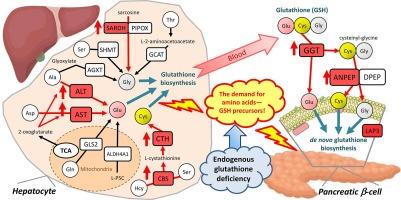The link between the ANPEP gene and type 2 diabetes mellitus may be mediated by the disruption of glutathione metabolism and redox homeostasis
IF 2.6
3区 生物学
Q2 GENETICS & HEREDITY
引用次数: 0
Abstract
Aminopeptidase N (ANPEP), a membrane-associated ectoenzyme, has been identified as a susceptibility gene for type 2 diabetes (T2D) by genome-wide association and transcriptome studies; however, the mechanisms by which this gene contributes to disease pathogenesis remain unclear. The aim of this study was to determine the comprehensive contribution of ANPEP polymorphisms to T2D risk and annotate the underlying mechanisms. A total of 3206 unrelated individuals including 1579 T2D patients and 1627 controls were recruited for the study. Twenty-three common functional single nucleotide polymorphisms (SNP) of ANPEP were genotyped by the MassArray-4 system. Six polymorphisms, rs11073891, rs12898828, rs12148357, rs9920421, rs7111, and rs25653, were found to be associated with type 2 diabetes (Pperm ≤ 0.05). Common haplotype rs9920421G-rs4932143G-rs7111T was strongly associated with increased risk of T2D (Pperm = 5.9 × 10–12), whereas two rare haplotypes such as rs9920421G-rs4932143C-rs7111T (Pperm = 6.5 × 10–40) and rs12442778A-rs12898828A-rs6496608T-rs11073891C (Pperm = 1.0 × 10–7) possessed strong protection against disease. We identified 38 and 109 diplotypes associated with T2D risk in males and females, respectively (FDR ≤ 0.05). ANPEP polymorphisms showed associations with plasma levels of fasting blood glucose, aspartate aminotransferase, total protein and glutathione (P < 0.05), and several haplotypes were strongly associated with the levels of reactive oxygen species and uric acid (P < 0.0001). A deep literature analysis has facilitated the formulation of a hypothesis proposing that increased plasma levels of ANPEP as well as liver enzymes such as aspartate aminotransferase, alanine aminotransferase and gammaglutamyltransferase serve as an adaptive response directed towards the restoration of glutathione deficiency in diabetics by stimulating the production of amino acid precursors for glutathione biosynthesis.

ANPEP 基因与 2 型糖尿病之间的联系可能是通过破坏谷胱甘肽代谢和氧化还原平衡介导的。
氨基肽酶 N(ANPEP)是一种与膜相关的外切酶,已被全基因组关联和转录组研究确定为 2 型糖尿病(T2D)的易感基因;然而,该基因对疾病发病机制的作用机制仍不清楚。本研究旨在确定 ANPEP 多态性对 T2D 风险的综合贡献,并注释其潜在机制。该研究共招募了 3206 名无血缘关系的个体,包括 1579 名 T2D 患者和 1627 名对照者。通过 MassArray-4 系统对 ANPEP 的 23 个常见功能性单核苷酸多态性(SNP)进行了基因分型。研究发现,rs11073891、rs12898828、rs12148357、rs9920421、rs7111 和 rs25653 这六个多态性与 2 型糖尿病相关(Pperm ≤ 0.05)。常见单倍型 rs9920421G-rs4932143G-rs7111T 与 T2D 风险增加密切相关(Pperm = 5.9 × 10-12),而两种罕见单倍型如 rs9920421G-rs4932143C-rs7111T (Pperm = 6.5 × 10-40)和 rs12442778A-rs12898828A-rs6496608T-rs11073891C (Pperm = 1.0 × 10-7)等两个罕见单倍型对疾病具有很强的保护作用。我们在男性和女性中分别发现了 38 个和 109 个与 T2D 风险相关的二联型(FDR ≤ 0.05)。ANPEP 多态性与血浆中的空腹血糖、天冬氨酸氨基转移酶、总蛋白和谷胱甘肽水平有关(P
本文章由计算机程序翻译,如有差异,请以英文原文为准。
求助全文
约1分钟内获得全文
求助全文
来源期刊

Gene
生物-遗传学
CiteScore
6.10
自引率
2.90%
发文量
718
审稿时长
42 days
期刊介绍:
Gene publishes papers that focus on the regulation, expression, function and evolution of genes in all biological contexts, including all prokaryotic and eukaryotic organisms, as well as viruses.
 求助内容:
求助内容: 应助结果提醒方式:
应助结果提醒方式:


